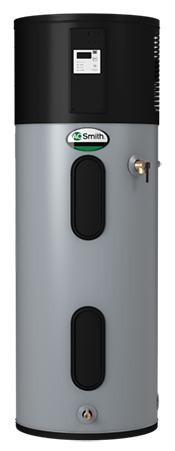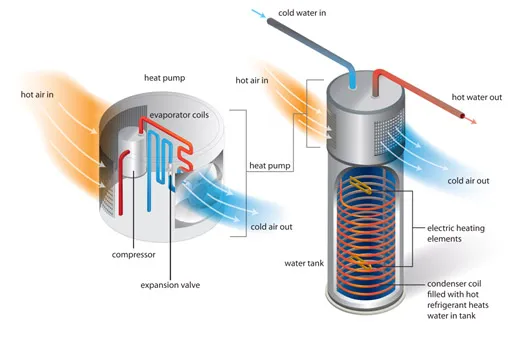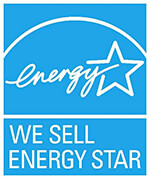How a Heat Pump Water Heater Works
Heat pump water heaters continue to grow in popularity with our customers in the Denver-Boulder metro area. This is due in large part to their electrically efficient designs and zero reliance on fossil fuels such as natural gas and propane. With the steady growth of these domestic hot water products, options to select from are also increasing.
Our hot water team at Save Home Heat Company feels that now is a good time to talk in a little more depth about how these unique water heaters do their job. We’ll present a brief overview of their main components and how they work together, and we’ll also take a quick look at the two most popular heat pump water heater designs currently available.


What Is a Heat Pump Water Heater?
A heat pump water heater is an efficient, electric-powered, tank style water heater that employs heat pump technology, using refrigerant in a sealed system to create hot water. The theory of operation of heat pump water heaters is similar to the central and mini-split heat pumps that our team installs for heating and cooling homes. In this case, however, the unit employs the refrigerant to heat your domestic hot water.
Heat pump water heaters do not burn fossil fuels such as natural gas or propane, and are considered to be a “green” home appliance. Both 240 volt and 120 volt units are available; our team at Save Home Heat almost exclusively installs 240 volt models due to their higher performance.
Historical Perspective on Heat Pump Water Heaters
Heat pump water heaters are not new to our industry: they first became available in the residential market approximately 40 years ago, primarily overseas at first. Heat pump technology, as a whole, has been around much longer. Approximately 15 years ago, these products began to gain more traction in the U.S., stimulated by national regulations requiring higher efficiency ratings in electric water heaters.

Self-Contained vs. Split-System Heat Pump Water Heater Designs
Generally speaking, heat pump water heaters are available in two types of designs:
1) Fully self-contained units that are found in traditional water heater locations; and
2) Split-system designs,
whose primary components are an indoor storage tank in the conventional location, plus an outdoor condensing unit (similar in appearance to mini-split outdoor units).
Self-contained heat pump water heaters are currently the more prevalent product in our country, but there are signs that this could be starting to shift a little. The split-system design has been popular in Japan and other countries for over two decades, and the alternative it offers appears to be gaining momentum here.
Self-Contained Heat Pump Water Heaters
Self-contained heat pump water heaters, as the name indicates, contain all components and the storage tank in a single unit, installed in the traditional water heater location.
With these products, a certain amount of operating sound is to be expected, so the location of the mechanical room can be very important, as well as the options for bringing air into the unit and exhausting outgoing air. Having a mechanical room that’s well insulated from the rest of the house can be very helpful in controlling operating sound levels in the home. Our team currently installs heat pump water heaters of this design manufactured by A.O. Smith and Rheem.

Split-System Heat Pump Water Heaters
As mentioned above, the split-system design combines a compact outdoor condensing unit with an indoor storage tank. The outdoor unit houses the compressor, condenser, evaporator coil, fan, and other key components. It also contains the pump that circulates cold domestic water from inside the home to the outdoor unit, where the water is heated, and back to the storage tank. This type of system incorporates a triple-failsafe design to prevent potential freezing of the water.
Where indoor space is very tight, or if there are significant indoor operating sound concerns, the split-system heat pump water heater design is well worth a closer look (more on that below). The SANCO2 from ECO2 Systems is the split-system heat pump water heater that we currently recommend.
What Are the Primary Components in Heat Pump Water Heaters?
 Looking closer at the design of self-contained indoor heat pump water heaters, many – but not all – of the key components are located in the upper compartment.
Looking closer at the design of self-contained indoor heat pump water heaters, many – but not all – of the key components are located in the upper compartment.
Here’s a brief overview of the primary components inside a fully self-contained, indoor heat pump water:
Compressor: Located in the upper compartment, the compressor is the heart of the system, the most important component in the process of employing refrigerant to create heat for heating your domestic water.
Storage Tank: The domestic storage tank is of course important, and in this design it’s where heat from the condenser heats the water in the tank. Storage tank sizes that our team installs are typically in the 50 gallon to 80 gallon range.
Condenser: The condenser in a heat pump water heater can be thought of as a heat exchanger, where heat from hot, liquid-state refrigerant is transferred to your domestic water. In the self-contained design, the condenser is submerged inside storage tank.
Evaporator Coil: The evaporator coil works with the fan in the upper compartment, helping to change refrigerant in the sealed system from a liquid back to a gas, another important step as the refrigeration cycle continues during operation of the unit.
Fan: The fan brings air into the upper compartment, blowing through the evaporator coil, as described above.
Backup Heating Elements: Worth noting, the storage tank on these systems normally contains backup electric heating elements, to ensure ample hot water supply and to assist in meeting peak hot water demand, if needed.
Refrigerant: While not technically a component, it absolutely makes sense to mention the all-important refrigerant gas that’s contained in the closed system in all heat pump water heaters (and other heat pumps, too). Simply put, the refrigerant in the system flows through the compressor, the condenser, and the evaporator coil, as its phase-change characteristics are employed to create heat.

Diving just a little deeper:
With the “aid” of the components mentioned above, as the refrigerant circulates thru the system, going from the gaseous state to liquid and back again, in a continuing cycle, heat is created in the process. In the case of these products, that heat is exchanged to your domestic water supply, which is then stored in a relatively conventional manner in a storage tank located in your mechanical area.
How Do Split-System Components Differ?
The primary components in split-system heat pump water heaters are, in function, virtually identical to self-contained designs. However, in the case of the split-system design, many of those key components are located in the outdoor unit – and they may also look a little different.
Most notably, in the split-system version of these water heaters the compressor and the fan – the components that produce the loudest operating sounds – are located in the outdoor unit. The condenser is also located in the outdoor unit, along with a circulating pump, whose purpose is to bring cold domestic water from inside the house into the outdoor unit, and return heated water to the storage tank, indoors.
 Some important takeaways on split-system heat pump water heaters: The loudest components are all located in the outdoor unit. In addition, in our region, before purchasing one of these systems, make sure you take the time to fully understand their triple-failsafe, freeze-proof design.
Some important takeaways on split-system heat pump water heaters: The loudest components are all located in the outdoor unit. In addition, in our region, before purchasing one of these systems, make sure you take the time to fully understand their triple-failsafe, freeze-proof design.
How Does a Heat Pump Water Heater Produce Hot Water?
Hopefully tying the above information together, you can simply think of a heat pump water heater as an air conditioner or a refrigerator that’s running in reverse, producing heat instead of cooling – and the heat it’s producing is being used to heat hot water. We admit, the imagery can get a little mixed up!
Now let’s take a closer look at the refrigeration cycle as it relates to heat pump water heaters, focusing on the self-contained models:
1) The refrigerant in the system changes state from a gas to a superheated liquid inside the compressor
2) The hot, liquid-state refrigerant then flows from the compressor to the inside of the condenser that’s submerged in the storage tank
3) Heat inside the condenser is exchanged to the domestic water in the tank
4) While heating water in the tank, the refrigerant in the condenser begins turning back into the gaseous state
5) The refrigerant in the condenser flows back toward the compressor, first going through the evaporator coil
6) The fan blows air across the evaporator coil, completing the phase change back into a gas before the refrigerant re-enters the compressor.This cycle continues steadily, heating domestic water until the temperature setting on the storage tank’s thermostat is satisfied and the system shuts down automatically.
Your Denver-Boulder Metro Area Water Heater Experts
Our team at Save Home Heat Company takes the time to carefully advise our customers about the applications of these and other trend-setting hot water products, clearly and patiently answering all questions in a friendly, low-pressure manner.
If a heat pump water heater isn’t the right fit for your family and your home, you can rely on us to make recommendations that we feel are the best match for your needs. Our broad water heater line includes standard and high recovery gas- and propane-fired tank water heaters, direct-vent heaters, whole-house tankless heaters, point-of-use products, as well as indirect-fired water heaters built for hot water boiler heating systems.
To learn more about water heater options that are the right fit for you and your Boulder-Denver metro area home, please reach out to our helpful team today to schedule an appointment for an installation quote. All quotes are highly informative, low-pressure, and free. We can also assist you in obtaining substantial rebates from Xcel Energy for installing a qualifying heat pump water heater, and inform you of other rebates that may be available.
If it’s hot water for your Denver-Boulder area home, our team at Save Home Heat has all your bases covered!

Please contact me to schedule a replacement water heater quote!




